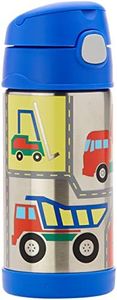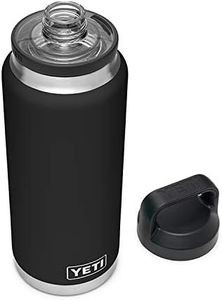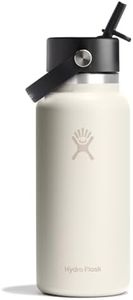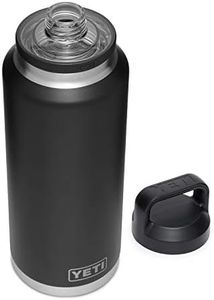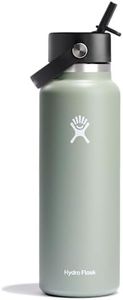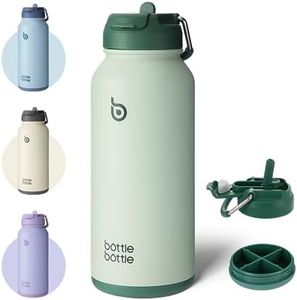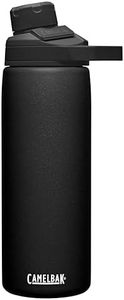We Use CookiesWe use cookies to enhance the security, performance,
functionality and for analytical and promotional activities. By continuing to browse this site you
are agreeing to our privacy policy
10 Best Water Bottles
From leading brands and best sellers available on the web.Buying Guide for the Best Water Bottles
Choosing the right water bottle may seem straightforward, but with so many options available, it's worth considering your lifestyle and how you'll use it. Think about when and where you plan to use your bottle most frequently: for sports, commuting, hiking, or just sitting on your desk. Understanding your habits will help narrow down the features that matter most and ensure you get a water bottle you’ll be happy to use every day.CapacityCapacity refers to how much liquid the bottle can hold, usually measured in ounces or liters. This is important because it determines how much water you'll have on hand between refills. Smaller bottles, often 12–18 ounces, are lightweight and easy to carry but may require frequent refilling, making them good for quick outings or for kids. Medium-sized bottles, about 20–32 ounces, are a popular all-around choice—big enough for a few hours but still portable. Larger bottles (over 32 ounces) can be heavy when full but are great if you want lots of hydration for longer activities, like hiking or working at a desk all day. Choose the size that fits your typical activity and how much weight you’re willing to carry.
MaterialWater bottles come mainly in plastic, stainless steel, and glass. Plastic bottles are lightweight and usually affordable, but may retain flavors and, unless marked BPA-free, could have potential health concerns. Stainless steel bottles are more durable and can keep drinks hot or cold for longer, though they’re typically heavier and pricier. Glass bottles don’t retain flavors and are easy to clean, but they can be heavy and breakable, although most come with a protective sleeve. Your choice should depend on how much you value durability, weight, insulation, and taste purity.
InsulationInsulation is about whether the bottle can keep drinks hot or cold for extended periods. Non-insulated bottles won’t maintain temperature, but are lighter and sometimes cheaper. Single-wall bottles are good enough if you just want to carry water and don't care about temperature. Insulated bottles, often double-walled stainless steel, can keep water cold for many hours or coffee hot for a decent time. If you love having ice-cold water or warm beverages on the go, look for insulated options. Pick based on whether you need your drink to stay at a certain temperature while you're out.
Lid TypeThe lid type refers to how the bottle opens and how you drink from it. Common types include screw tops, flip tops, straws, and spouts. Screw tops usually seal well and are leakproof, great for tossing into a bag, but may require two hands to open. Flip tops and straws are handy for quick, one-handed drinking, making them useful for athletes or drivers, but sometimes can be a bit harder to clean. Some bottles offer built-in strainer or filter options for infusing flavors or filtering water. Think about where you’ll use your bottle and pick a lid design that matches—easy sipping on the go, complete leak protection, or simple maintenance.
Ease of CleaningThis is about how simple it is to keep your bottle clean and hygienic. Wide-mouthed bottles are easier to scrub and fit ice cubes, while narrow-mouthed ones may need special brushes. Bottles that can be taken apart (labelled as dishwasher-safe) simplify regular cleaning. If you plan to use your bottle for drinks other than water, or if you'll be refilling it constantly, consider how easy it is to clean all the parts, as this will help prevent mold and odors from building up.
DurabilityDurability means how well a bottle holds up under regular use, drops, or bumps. Stainless steel and some plastics can withstand rough handling, while glass bottles can break if dropped but often have protective sleeves. If your bottle will travel outdoors or withstand being dropped, focus on more rugged options. For desk or gentle use, durability is less of an issue, so you can prioritize other features like taste or ease of use.
PortabilityPortability covers how easy it is to take your bottle with you. Smaller, lighter bottles are easy to carry in a bag or by hand, and some feature handles, loops, or carabiners. Larger bottles may have handles but can be heavy, so consider where and how you’ll carry it. If you walk or commute a lot, look for a comfortable carrying feature; if the bottle mostly stays on your desk, size and weight matter less.




